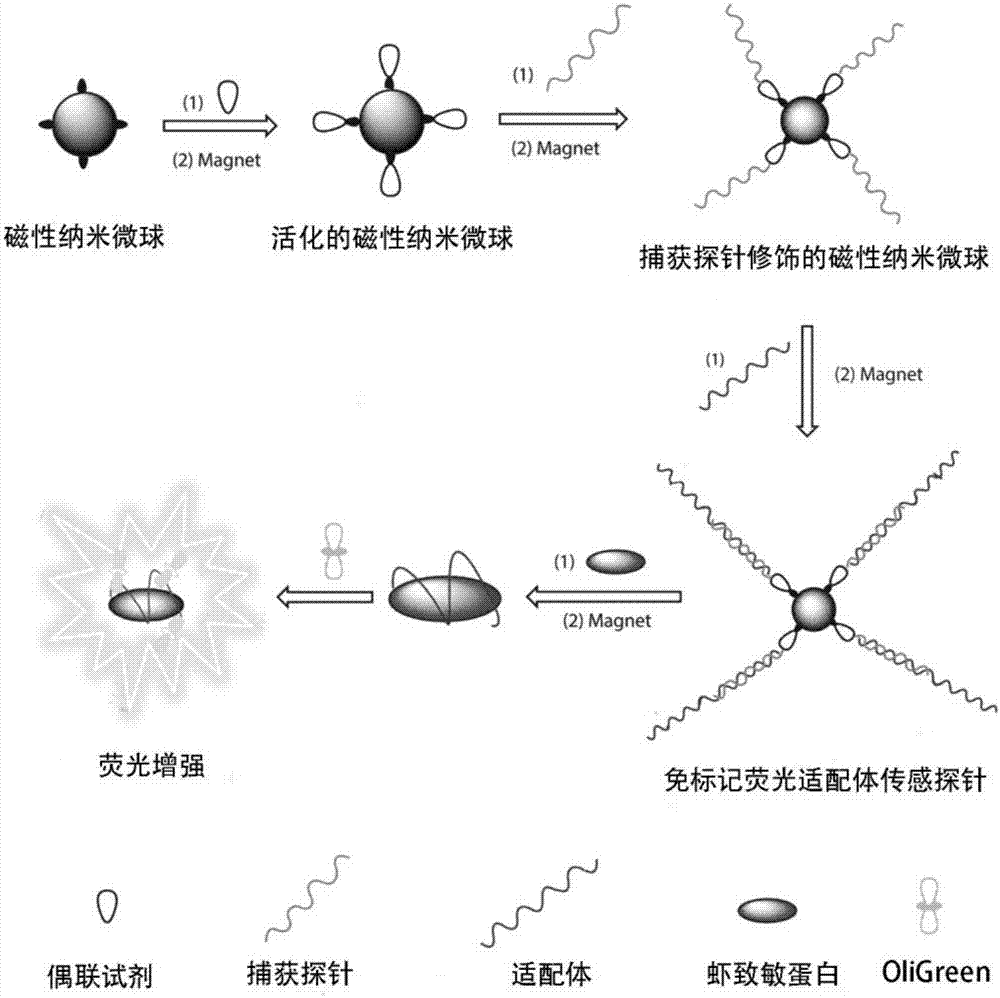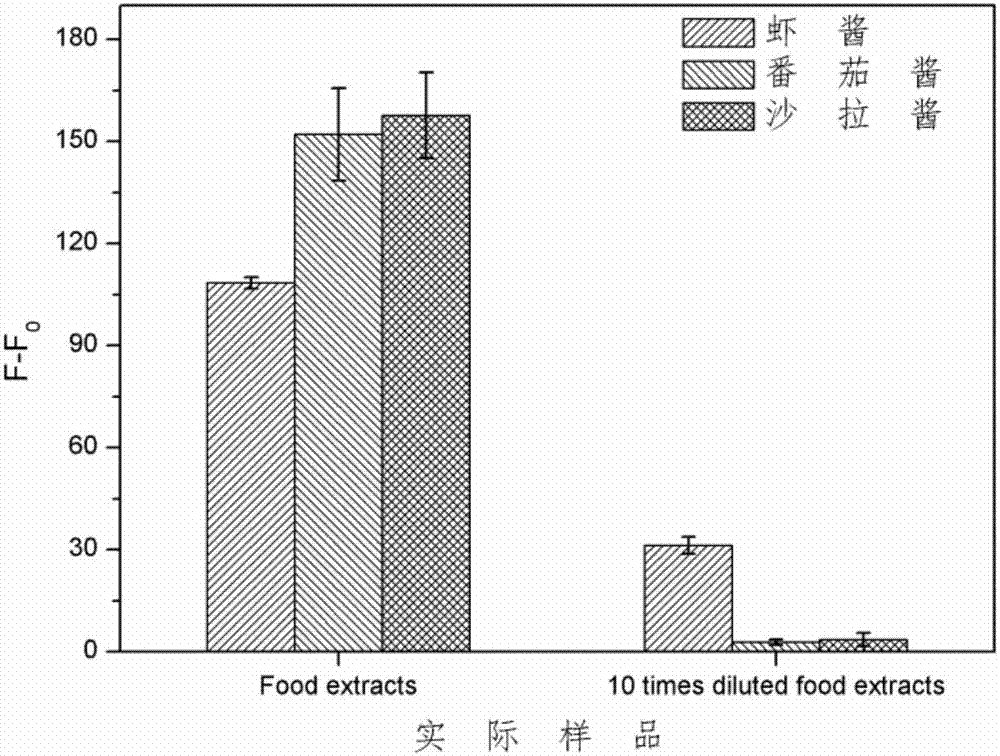Label-free fluorescence aptamer sensor and preparation method and application thereof
An aptamer sensor and label-free technology, which is applied in the field of protein analysis and detection, can solve the problems of reducing nucleic acid aptamers, complicated operation procedures, and low repeatability, and achieve simplified detection processes, excellent selectivity and specificity, and reduced or the effect of eliminating interference
- Summary
- Abstract
- Description
- Claims
- Application Information
AI Technical Summary
Problems solved by technology
Method used
Image
Examples
Embodiment 1
[0034] 1. Preparation of dsDNA probes: Mix magnetic nanospheres (1 mL, 20 μg / mL) with amino groups on the surface and coupling reagent Sulfo-SMCC (10 μL, 5 mg / mL), incubate at room temperature for 60 min; remove excess by magnetic separation Coupling reagents, 5' end thiol-modified capture probes (1 mL, 2 μmol / L) were added, mixed well, and incubated at room temperature for 24 h. Remove the reaction solution by magnetic separation, wash the magnetic nanospheres with 0.01mol / L Tris-HCl buffer solution of pH 7.5 three times, then add aptamer (1mL, 0.5μmol / L) and mix with them, incubate at 95°C for 5min, and cool down slowly to room temperature. The magnetic nanospheres were washed three times with 0.01mol / L, pH 7.5 Tris-HCl buffer, and then redispersed in 1 mL, 0.01mol / L, pH 7.5 Tris-HCl buffer to obtain magnetic nanoparticles assembled with capture probes. Microspheres.
[0035]2. Quantitative detection of shrimp allergenic protein: Take 40 μL of sensing probe stock solution ...
Embodiment 2
[0037] To detect other proteins:
[0038] Take 40 μL of the sensing probe stock solution and dilute it to 150 μL with 0.01mol / L, pH 7.5 Tris-HCl buffer, add 50 μL, 5 μg / mL of shrimp allergenic protein (Tropomyosin) and 50 μL, 10 μg / mL bovine serum albumin (BSA), lysozyme (Lysozyme), streptavidin (Streptavidin), β-conglycinin (β-Conglycinin), etc. were mixed and incubated at 37°C for 120min. Remove the magnetic nanospheres by magnetic separation, add an equal volume of OliGreen working solution, incubate at room temperature in the dark for 40 minutes, and immediately measure on the machine to observe the change of the fluorescence signal. The results show( figure 2 -B), The fluorescent signal changes caused by the shrimp allergenic protein are very significant, while the other proteins only cause small changes in the fluorescent intensity. The result shows that the label-free fluorescent aptasensor of the present invention has high specificity and specificity.
Embodiment 3
[0040] Detection in real samples:
[0041] 50mg of shrimp sauce, tomato sauce and salad dressing were mixed with 1mL, 0.02mol / L, pH 7.5 Tris-HCl buffer and homogenized for 20min, then overnight at 4°C, centrifuged (15000g, 30min) to remove large particles and suspended matter, Take the supernatant to obtain the original extract. The extract and its 10-fold diluted extract with 0.02mol / L, pH 7.5 Tris-HCl buffer were used as actual samples. Then, the sample was detected according to the above-mentioned label-free aptamer sensor detection method, and the detection results were as follows: image 3 shown. Like shrimp paste, the original extracts of tomato sauce and salad dressing caused significant changes in fluorescence signals, but after 10-fold dilution with 0.02mol / L, pH 7.5 Tris-HCl buffer, only negligible fluorescence signals were caused. Variety. However, the positive sample shrimp paste still caused a credible change in the fluorescent signal. This result shows that ...
PUM
| Property | Measurement | Unit |
|---|---|---|
| Diameter | aaaaa | aaaaa |
Abstract
Description
Claims
Application Information
 Login to View More
Login to View More - R&D
- Intellectual Property
- Life Sciences
- Materials
- Tech Scout
- Unparalleled Data Quality
- Higher Quality Content
- 60% Fewer Hallucinations
Browse by: Latest US Patents, China's latest patents, Technical Efficacy Thesaurus, Application Domain, Technology Topic, Popular Technical Reports.
© 2025 PatSnap. All rights reserved.Legal|Privacy policy|Modern Slavery Act Transparency Statement|Sitemap|About US| Contact US: help@patsnap.com



